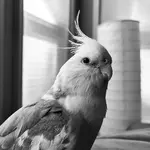Kirska
New member
- Dec 30, 2021
- 5
- 31
- Parrots
- Rey, cockatiel
Hello, this might be a long post so thank you for reading.
Background
My cockatiel Rey is 3 and I've had her since she was a baby. She's always eaten Harrison's with some treats. A little under a year ago, she had a big crash and I took her to the emergency vet. She was hospitalized for almost a week. They thought she would be paralyzed but she mostly recovered. She also hasn't laid eggs since then.
In the time since then, her spine has degraded gradually and she started to slump. It was very slow so I didn't notice right away. When I took her for a checkup at the vet, they noticed and didn't really have an explanation for it but figured it was a lingering effect of her crash. She goes to a board certified avian specialist.
Around a month ago, I took her to get her nails trimmed and her left femur ended up broken. They assured me she was not handled roughly. The vet did x-rays and CT scan and found that her spine and lower body all had really low bone density. Her leg bones were bowing. Her CT scan looks like her spine is just missing chunks. The vet gave her a vitamin D shot. I am giving her pain meds, calcium, and VetOmega/Procosa per vet's instructions. We also got her a UV bird lamp which is directly over the hospital fish tank I have her in, on for about 10 hours a day.
Fast forward to yesterday, and her right femur ended up breaking as well. No one handled her roughly, it just snapped. She was beginning to stand on the left leg again and seemed to be cheering up, and now we're back at square one. X-rays again, they said her left was looking better.
Prognosis
The vet has consulted with multiple other avian specialists around the country. Her CT scan was sent to Scott Echols and his opinion was that her bones had disuse atrophy. But she's always been a normal active bird. We have always taken her out of the cage and let her wander and hang out with us. He talks about that here as well https://www.avianstudios.com/metabolic-bone-disease/development-of-metabolic-bone-disease-in-birds/
Currently we are continuing current treatment and hoping for improvement. The vet thinks she will be permanently disabled by whatever serious disease she is dealing with. She thinking that in her big crash, she might've damaged her parathyroid.
The vet asked me to start doing gentle range of motion exercises with the left leg, which I started today, and Rey didn't object.
She is still eating and drinking fine. I have her tank setup so she can reach the food and water without moving around and I bring her out and give her popcorn treats. Before her left leg broke, she had cheered up and was singing at us and generally being her curious and fun self again.
Ideas/Thoughts
I am debating building her some kind of small stand/device to get her off the ground to where she can move her legs without putting all her weight on them. I've seen wheelchairs for ducks and chickens. But I am thinking more like taking an aviator harness and hanging it from a small frame so her legs touch the ground but her weight is supported by the harness. I don't know if this is a crazy idea but I'm an engineer and willing to try.
My googling hasn't turned up many other ideas for what I can do to help her. I am willing to try just about anything. I am not ready to give up on her and want to give her the best shot to get better before giving up. But I feel like I can only justify trying for maybe another month before I'd have to do what is best for her if she does not improve.
Please let me know if any of you have any thoughts, ideas, anything really.
Background
My cockatiel Rey is 3 and I've had her since she was a baby. She's always eaten Harrison's with some treats. A little under a year ago, she had a big crash and I took her to the emergency vet. She was hospitalized for almost a week. They thought she would be paralyzed but she mostly recovered. She also hasn't laid eggs since then.
In the time since then, her spine has degraded gradually and she started to slump. It was very slow so I didn't notice right away. When I took her for a checkup at the vet, they noticed and didn't really have an explanation for it but figured it was a lingering effect of her crash. She goes to a board certified avian specialist.
Around a month ago, I took her to get her nails trimmed and her left femur ended up broken. They assured me she was not handled roughly. The vet did x-rays and CT scan and found that her spine and lower body all had really low bone density. Her leg bones were bowing. Her CT scan looks like her spine is just missing chunks. The vet gave her a vitamin D shot. I am giving her pain meds, calcium, and VetOmega/Procosa per vet's instructions. We also got her a UV bird lamp which is directly over the hospital fish tank I have her in, on for about 10 hours a day.
Fast forward to yesterday, and her right femur ended up breaking as well. No one handled her roughly, it just snapped. She was beginning to stand on the left leg again and seemed to be cheering up, and now we're back at square one. X-rays again, they said her left was looking better.
Prognosis
The vet has consulted with multiple other avian specialists around the country. Her CT scan was sent to Scott Echols and his opinion was that her bones had disuse atrophy. But she's always been a normal active bird. We have always taken her out of the cage and let her wander and hang out with us. He talks about that here as well https://www.avianstudios.com/metabolic-bone-disease/development-of-metabolic-bone-disease-in-birds/
Currently we are continuing current treatment and hoping for improvement. The vet thinks she will be permanently disabled by whatever serious disease she is dealing with. She thinking that in her big crash, she might've damaged her parathyroid.
The vet asked me to start doing gentle range of motion exercises with the left leg, which I started today, and Rey didn't object.
She is still eating and drinking fine. I have her tank setup so she can reach the food and water without moving around and I bring her out and give her popcorn treats. Before her left leg broke, she had cheered up and was singing at us and generally being her curious and fun self again.
Ideas/Thoughts
I am debating building her some kind of small stand/device to get her off the ground to where she can move her legs without putting all her weight on them. I've seen wheelchairs for ducks and chickens. But I am thinking more like taking an aviator harness and hanging it from a small frame so her legs touch the ground but her weight is supported by the harness. I don't know if this is a crazy idea but I'm an engineer and willing to try.
My googling hasn't turned up many other ideas for what I can do to help her. I am willing to try just about anything. I am not ready to give up on her and want to give her the best shot to get better before giving up. But I feel like I can only justify trying for maybe another month before I'd have to do what is best for her if she does not improve.
Please let me know if any of you have any thoughts, ideas, anything really.




